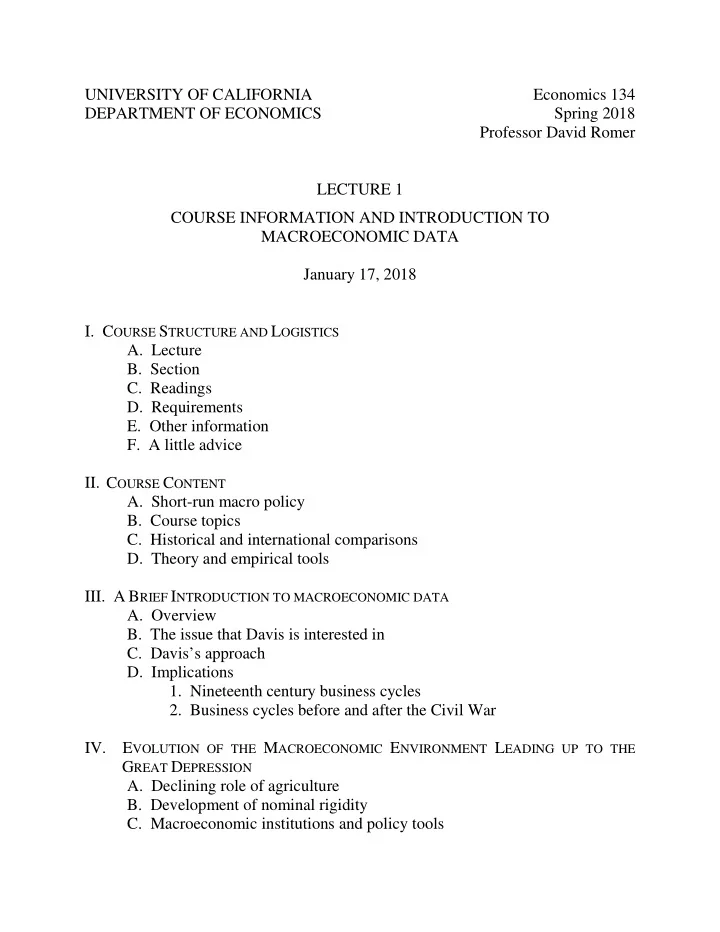

UNIVERSITY OF CALIFORNIA Economics 134 DEPARTMENT OF ECONOMICS Spring 2018 Professor David Romer LECTURE 1 COURSE INFORMATION AND INTRODUCTION TO MACROECONOMIC DATA January 17, 2018 I. C OURSE S TRUCTURE AND L OGISTICS A. Lecture B. Section C. Readings D. Requirements E. Other information F. A little advice II. C OURSE C ONTENT A. Short-run macro policy B. Course topics C. Historical and international comparisons D. Theory and empirical tools III. A B RIEF I NTRODUCTION TO MACROECONOMIC DATA A. Overview B. The issue that Davis is interested in C. Davis’s approach D. Implications 1. Nineteenth century business cycles 2. Business cycles before and after the Civil War IV. E VOLUTION OF THE M ACROECONOMIC E NVIRONMENT L EADING UP TO THE G REAT D EPRESSION A. Declining role of agriculture B. Development of nominal rigidity C. Macroeconomic institutions and policy tools
Economics 134 David Romer Spring 2018 L ECTURE 1 Course Introduction and Introduction to Historical Data January 17, 2018
O UTLINE I. C OURSE S TRUCTURE AND L OGISTICS A. Lecture B. Section C. Readings D. Requirements E. Other information F. A little advice
Lecture Rules • No electronic devices (laptops, ipads, phones)
GSIs • Dennis Egger • Emily Eisner • Matthias Hoelzlein • Benjamin Scuderi
Reading • Short-Run Fluctuations by David Romer. • Book chapters, journal articles, and policy analyses. There is reader at Copy Central, 2576 Bancroft, containing Short-Run Fluctuations and the readings that are not available online.
Requirements • 4 graded problem sets and participation (10%) • Midterm – Wednesday, March 7, in lecture (25%) • Short paper – due Monday, April 16 (25%) • Final – Monday, May 7, 3–6 P.M. (40%)
Other Requirements • You are expected to attend lecture, and you are responsible for the material covered in lecture (and for any announcements made in lecture). • Questions designed to test whether you did the readings are fair game for exams.
Other Information • My office hours • Thursdays, 4:00–5:30, 683 Evans • Course website: https://www.econ.berkeley.edu/course/2017- 18/spring-2018/economics-134 • Enrollment questions • Make sure to attend your first section meeting. • You can contact the head GSI for economics at headgsi@econ.berkeley.edu.
A Little Advice • Keep up! • Engage!
O UTLINE II. C OURSE C ONTENT A. Short-run macro policy B. Course topics C. Historical and international comparisons D. Theory and empirical tools
Course Topics • Monetary policy • Fiscal policy • Nonmonetary factors in recessions • Financial crises
Tools of the Course • Theory • IS/LM/MP model and extensions • Models of particular phenomena • Empirical Analysis • Linear regression • Careful treatment of causation
O UTLINE III. A B RIEF I NTRODUCTION TO M ACROECONOMIC D ATA A. Overview B. The issue that Davis is interested in C. Davis’s approach D. Implications 1. Nineteenth century business cycles 2. Business cycles before and after the Civil War
Two Important Messages about Macroeconomic Data • Just because they’re in a book or on a website doesn’t necessarily mean that they’re correct. • Just because they’re not in a book or on a website doesn’t necessarily mean you can’t get them.
Example: How Might You Go Wrong Measuring Real Output Using the Dollar Volume of Bank Clearings? • Bank clearings can move because of changes in quantities or prices. • Real output might not normally move one-for-one with real bank clearings. • The relationship between real bank clearings and real output can change. – Example: A financial crisis causes people to stop using checks.
How Else How Might You Try to Learn about the Behavior of Real Output in the Distant Past? • Data on specific types of output • Data on variables related to output: measures of inputs, exports and imports, financial variables, payrolls, …. • Historical descriptions of business conditions or economic prosperity. • Constructing data on as much of output as possible from a wide range of sources. • …
Examples of Series that Davis Uses
Examples of Series that Davis Uses (continued)
Examples of Series that Davis Uses (continued)
Some Basic Information about the Davis Index
The Davis Index and Some Alternatives
What Do We Mean by “Business Cycle”? • One common definition: departures of output from its normal or flexible-price level caused by nominal wage or price rigidity.
The Index’s Implications about the Severity of 19 th Century Recessions
Banking panics are often reflected in a spike in interest rates. Commercial Paper Rate (Percent) 10 20 30 40 50 60 0 01/05/1872 06/06/1873 11/06/1874 04/07/1876 09/07/1877 Commercial Paper Rate 02/07/1879 07/09/1880 12/09/1881 05/11/1883 10/17/1884 1869-1929 03/19/1886 08/19/1887 01/18/1889 06/20/1890 11/20/1891 04/20/1893 09/21/1894 02/21/1896 07/23/1897 12/23/1898 05/25/1900 10/25/1901 03/27/1903 08/26/1904 01/26/1906 06/28/1907 11/27/1908 04/29/1910 09/29/1911
IV. E VOLUTION OF THE M ACROECONOMIC E NVIRONMENT L EADING UP TO THE G REAT D EPRESSION
Fraction of Workers in Agriculture 76 66 56 Percent 46 36 26 16 6 1820 1830 1840 1850 1860 1870 1880 1890 1900 1910 1920 1930 1940 The U.S. was a major industrial power by the late 1800s.
Nominal Rigidity • Developed over the 1800s. • Was substantial by early 1900s. • May have gotten greater in the 1920s.
Rise of Macro Policy • Federal Reserve founded in 1913. • Income tax introduced in 1913. • Government spending increased substantially around World War I.
Government Spending as a Percent of GDP Spending rose as a share of GDP in WW I and after.
Recommend
More recommend